Texas Redistricting: A Lone Swing Seat in the Lone Star State?
November 15, 2021 · 1:09 PM EST
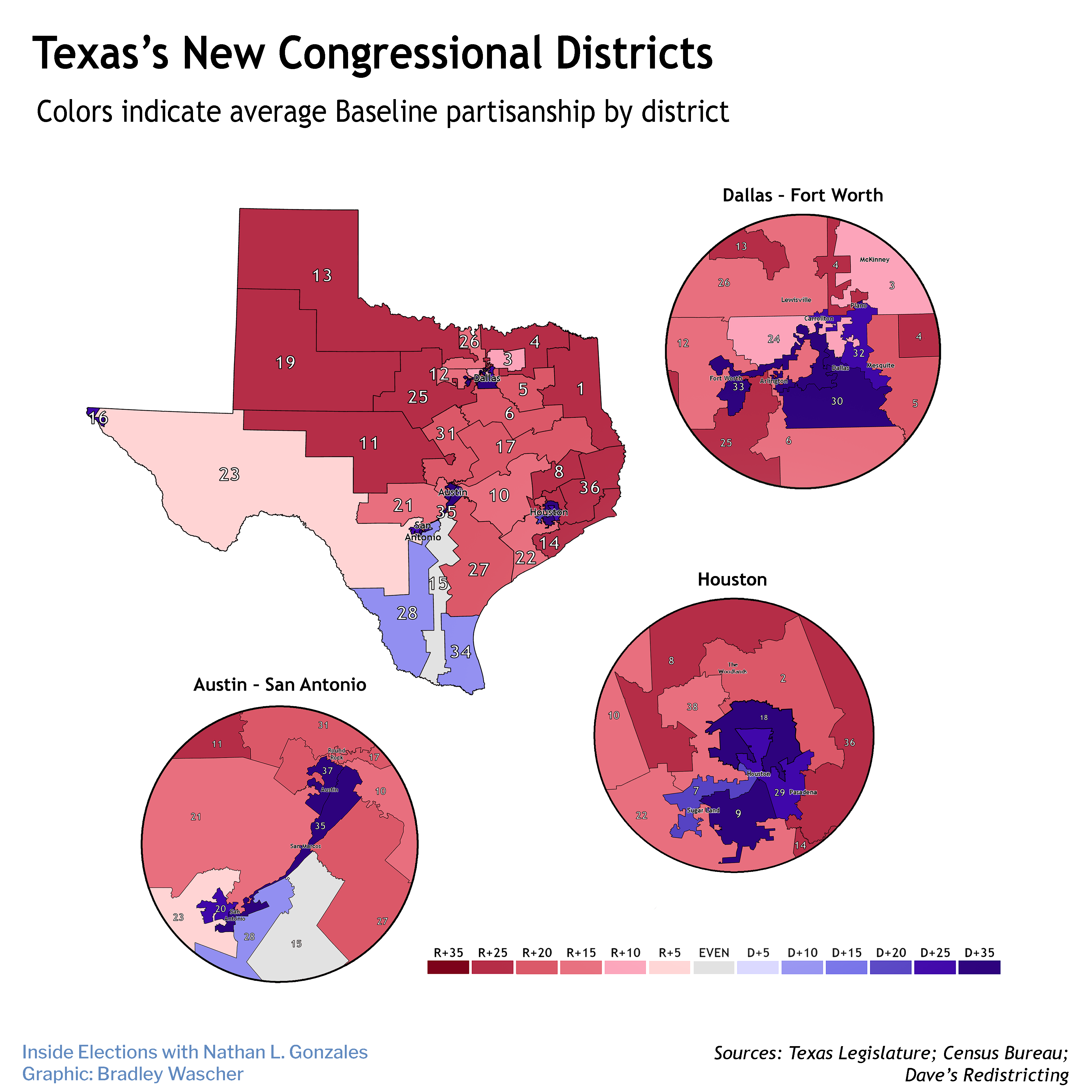
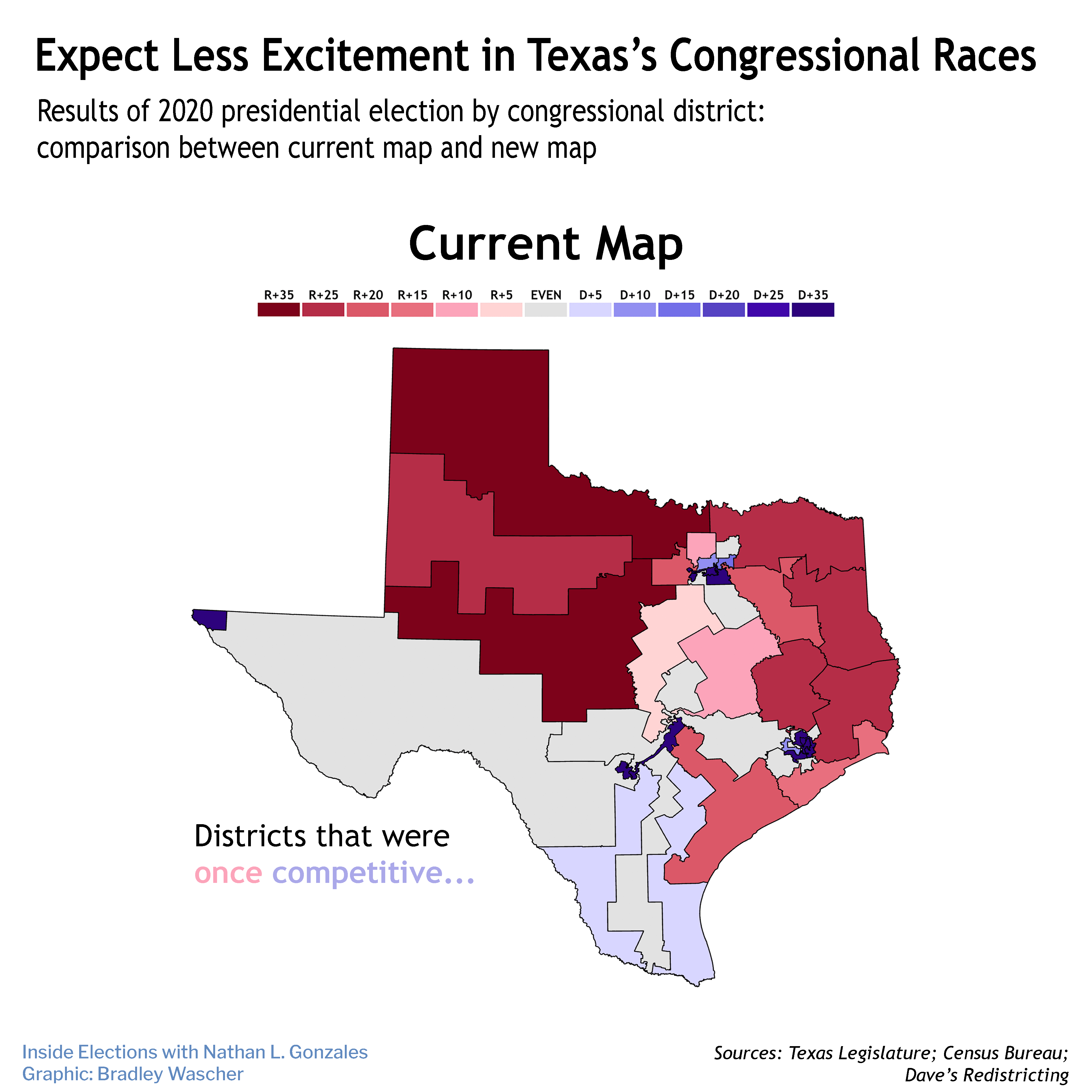 One of the largest states in the country will host some of the fewest competitive House races over the next decade. By signing into law Texas’s new congressional map late last month, Republican Gov. Greg Abbott approved a plan that will likely make federal elections in the state much less exciting.
One of the largest states in the country will host some of the fewest competitive House races over the next decade. By signing into law Texas’s new congressional map late last month, Republican Gov. Greg Abbott approved a plan that will likely make federal elections in the state much less exciting.
Texas gained two new congressional districts as a result of census reapportionment, the only state this cycle to net more than one seat, increasing the size of its congressional delegation from 36 members to 38. One of the new districts, the 37th, will be located in Austin and is expected to vote dependably Democratic. The second new district, the 38th, will be located in the Houston suburbs and will vote reliably Republican.
As for the 36 other districts, the new map largely solidifies existing partisan preferences.
The Texas congressional delegation is currently made up of 23 Republicans and 13 Democrats. The new map creates 24 districts that are Republican-favored, 13 districts that are Democrat-favored, and one district where neither party has a clear advantage, according to the Inside Elections Baseline metric, which captures each party’s political performance in a congressional district by combining all federal and state election results over the past four election cycles into a single average. In the 2020 election in particular, President Donald Trump carried 22 districts under the current lines while Joe Biden won 14. Under the new lines, Trump would have carried 25 districts to Biden’s 13.
The most likely range of outcomes for the Texas delegation is a GOP net gain of a seat or two. A GOP win in the newly-drawn 15th District (potentially the only competitive race in the state) would take the current 23R-13D delegation to 25 Republicans and 13 Democrats. A Democratic win in the 15th would mean no net change for the delegation at 24R and 14D.
In some respects, this is an attempt by the GOP to play the long game. By the end of the 2010s, many suburban districts under the current map began trending quickly toward Democrats. The new map greatly reduces the likelihood that any seats change hands. Rather than going for a gerrymander that directly cut Democrats’ number of seats, the GOP-controlled state legislature drew safer lines to protect incumbents from both parties, shoring up nearly every Republican incumbent who found themselves in competitive races in 2018 and 2020.
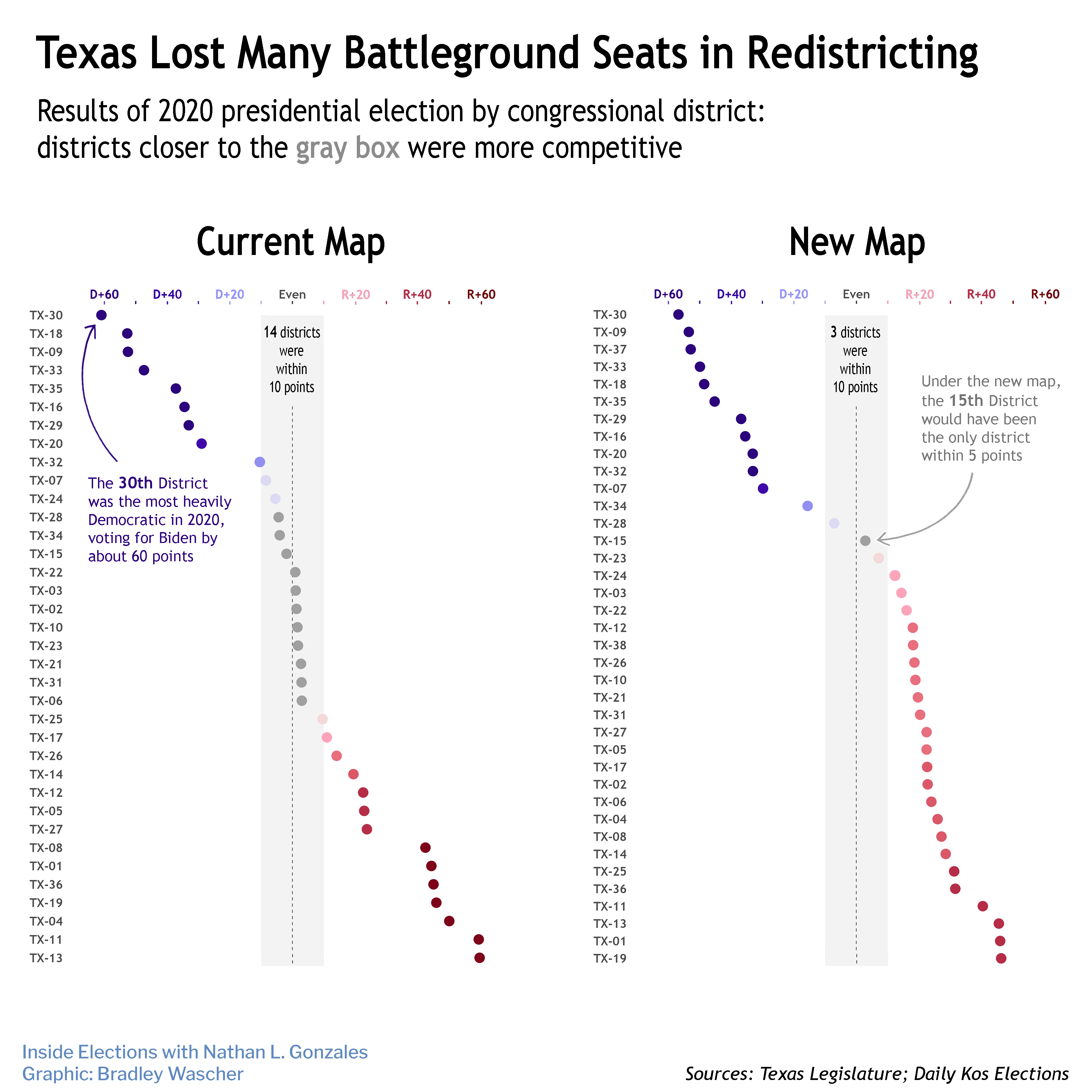
As a result, whereas 14 of Texas’s 36 current congressional districts (39 percent) voted within 10 points for either Trump or Biden in 2020, only three districts out of 38 (8 percent) would have voted within 10 points for either candidate under the new lines. In effect, the map benefits the GOP by placing a hard cap on Democrats’ potential gains for most of the next decade.
Texas gained seats because it gained people: according to census data, the statewide population ballooned by 16 percent between 2010 and 2020, the third-highest percent increase of any state over that period. Because Texas’s growth is heavily centered in cities and suburbs, it’s easy to understand why the Republican mapmakers drew the two additional seats in Austin and Houston. Their more controversial decision, though, was declining to design any new districts to represent Hispanic, Black, and Asian communities, despite these groups contributing to 95 percent of Texas’s population growth since 2010. With a number of lawsuits against the map having already been filed on the basis of racial discrimination, the Texas redistricting process might once again be headed for a long battle in the courts.
1st District
This northeast district, situated in the cities of Tyler and Longview, remains heavily Republican. According to Baseline, the new 1st is R+48.3, so Republican Rep. Louie Gohmert should have little problem seeking his tenth term in a district which Donald Trump carried by 46 points in 2020 — that is, of course, unless Gohmert instead chooses to run for attorney general (a crowded GOP primary has already developed in that race). At least one other Republican, former oil rig worker Aditya Atholi, has announced intentions to run in the 1st, but if Gohmert does decide to run for statewide office, more candidates will jump in to replace him. Initial Rating: Solid Republican
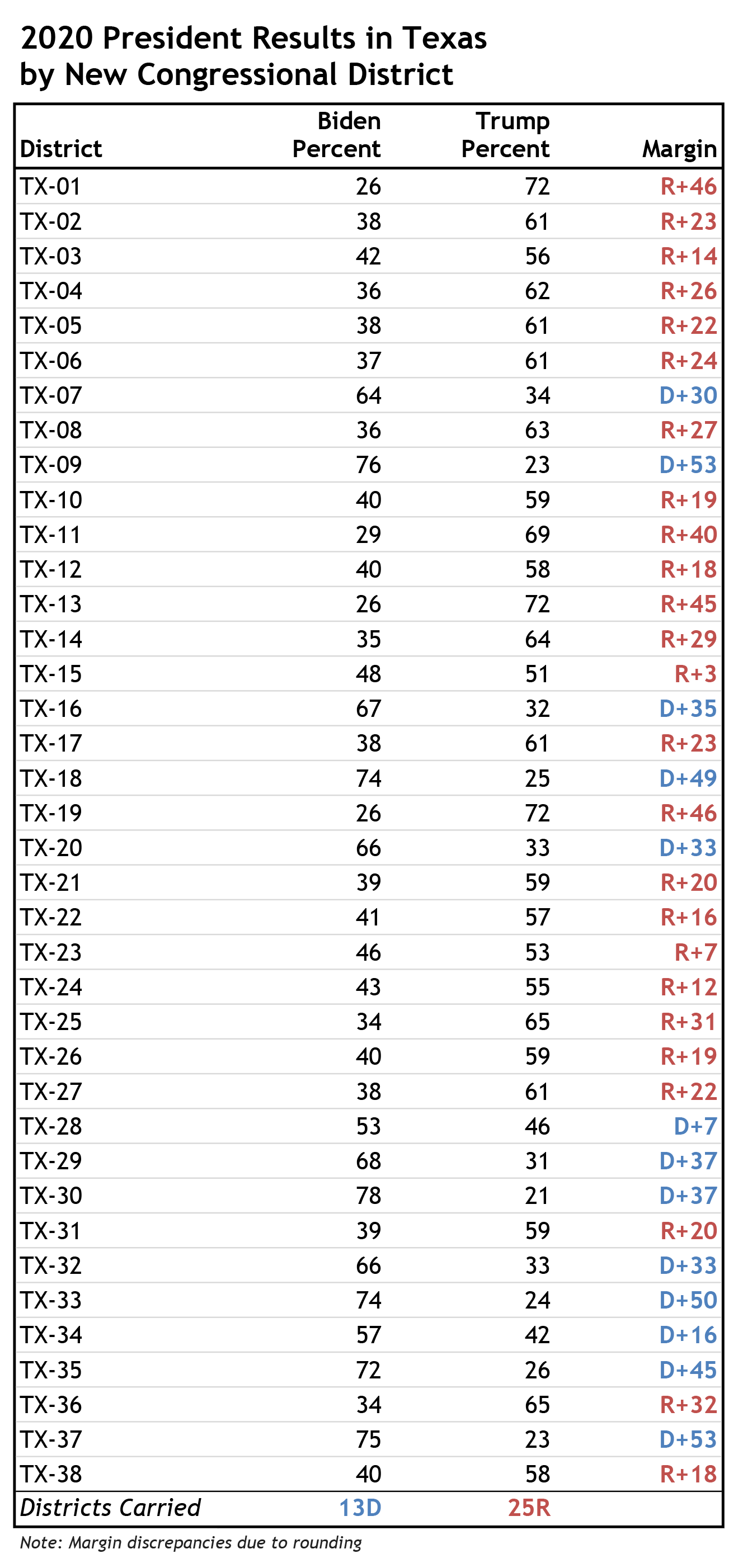
2nd District
With its boundaries changed noticeably, the 2nd becomes even more favorable for Republicans. Still located in the suburbs east and north of Houston, including the community of The Woodlands, the 2nd has a Baseline of R+36.1, and it would have voted for Trump by 23 points in 2020. Democrats targeted this area in 2018 and 2020 (when it was carried by Trump by just 1 point), but under the new lines Republican Rep. Dan Crenshaw, one of the top fundraisers in the House, is all but guaranteed re-election. Initial Rating: Solid Republican
3rd District
The 3rd is located in the suburbs north of Dallas, including McKinney. With a Baseline of R+30.5, this is a district that would have voted for Trump by 14 points in 2020 — that’s a major change from the old lines, under which Trump won by just 1 point. Republican Rep. Van Taylor seems set to secure a third term, although he might have a primary. Initial Rating: Solid Republican
4th District
Located in the northeast corner of the state and in the suburbs outside of Dallas, including Denison and Paris, the 4th should remain a GOP stronghold. The district has a Baseline of R+36.6, and it would have voted for Trump by 26 points in 2020 — good news for freshman Republican Rep. Pat Fallon. Initial Rating: Solid Republican
5th District
The 5th, located east of Dallas and anchored largely by Mesquite, appears set to elect Republican Rep. Lance Gooden to a third term. Having voted for Trump by 22 points in 2020, the district has a Baseline of R+29.7. Initial Rating: Solid Republican
6th District
Situated in the suburbs west and south of Dallas, while also grabbing portions of Arlington and wrapping up to Irving, the 6th is still a heavily GOP seat. The district’s Baseline is R+32, and it would have voted for Trump by 24 points in 2020. That’s a serious shift; under the old lines, the 6th voted for Trump by just 3 points and was targeted by Democrats in 2020. For freshman Republican Rep. Jake Ellzey, who was elected in a special election last July, the seat appears to be his to keep. Initial Rating: Solid Republican
7th District
Despite being one of Democrats’ most high-profile flips in the 2018 midterms with the victory of now-Rep. Lizzie Fletcher, the 7th is no longer competitive. GOP cartographers chose to make it a Democratic district in order to make surrounding districts more Republican. Still located in West Houston, including Bellaire, the district now bends south into Mission Bend rather than north into Jersey Village. The new 7th has a Baseline of D+17.3, and Joe Biden would have carried the district by 30 points in 2020. Initial Rating: Solid Democratic
8th District
Rep. Kevin Brady, the top Republican on the influential House Ways and Means Committee, announced his retirement in April, but he will almost surely be replaced by a member of his own party. The new 8th, located in the suburbs north of Houston including the city of Conroe, has a Baseline of R+35.8 and voted for Trump by 27 points in 2020. There’s already a crowded GOP primary brewing with 11 candidates filing so far. Notable contenders include Morgan Luttrell, a retired Navy SEAL and brother of Lone Survivor author Marcus Luttrell; and Christian Collins, a former Ted Cruz aide endorsed by the senator. Initial Rating: Solid Republican
9th District
Still located in South Houston, the 9th remains one of the most heavily Democratic districts in the state. The district has a Baseline of D+51.3 and voted for Biden by 53 points in 2020 — Democratic Rep. Al Green doesn’t have much to sweat. Initial Rating: Solid Democratic
10th District
The new 10th encircles the upper half of the Austin suburbs, and extends until it reaches approximately 30 miles west of Houston — essentially comprising the lower third of the Texas Triangle (similar to its previous configuration). Republican Rep. Michael McCaul got a scare in 2018 when he won by just 4 points against Democrat Mike Seigel. He beat Seigel in a 2020 rematch by a wider margin and won’t have to worry about any more competitive general elections in a new district that voted for Trump by 19 points. Overall, the 10th has a Baseline of R+29.4. Initial Rating: Solid Republican
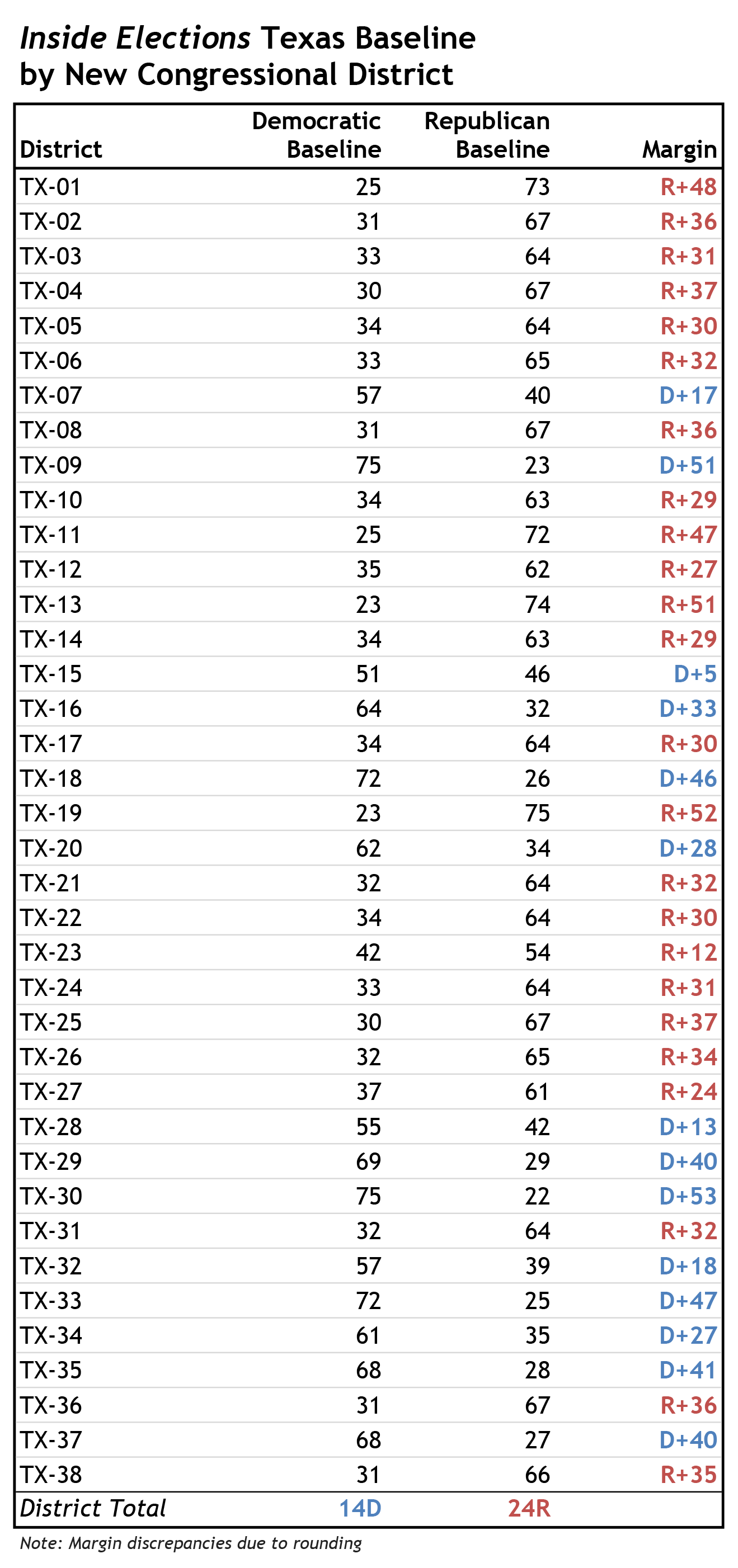
11th District
The 11th has shed some of its reach into the central parts of the state, but this West Texas district keeps the cities of Odessa and Midland. And it remains favorable for Republican Rep. August Pfluger: the district has a Baseline of R+46.5 and would have voted for Trump by 40 points in 2020. Initial Rating: Solid Republican
12th District
The new 12th is still located in the western portions of the Metroplex, running primarily through Fort Worth into the top half of Parker County. With a Baseline of R+27, it’s hard to see this Trump+18 district going for anyone other than Republican Rep. Kay Granger, should she choose to seek a 14th term. Initial Rating: Solid Republican
13th District
Situated up north in the Panhandle, and anchored by the city of Amarillo, the 13th has changed little in terms of geography or partisanship. Freshman Republican Rep. Ronny Jackson should have no problem running for another term in this district, which voted for Trump by 45 points in 2020 and has a Baseline of R+51.1. Initial Rating: Solid Republican
14th District
The 14th spans the Gulf Coast toward Texas’s border with Louisiana, and includes the city of Galveston. Still a heavily Republican district, the district has a Baseline of R+29.3 and voted for Trump by 29 points in 2020. Republican Rep. Randy Weber seems safe. Initial Rating: Solid Republican
15th District
The 15th cuts a straight line through south-central Texas, running approximately 250 miles from Hidalgo County to Guadalupe County. Republicans seized on Trump’s surprising performance in the Rio Grande Valley to redraw the 15th into a district that would have narrowly voted for the former president instead of Biden.
Democratic Rep. Vicente Gonzalez, who had an unexpectedly close race in 2020, says he’ll run in the neighboring, bluer 34th District instead of this one, making it an open seat race (a Democratic state representative tweaked the 34th at the last minute to include Gonzalez’s house). Two Democrats who worked for Gonzalez’s predecessor, Rep. Ruben Hinojosa, are running: former Labor Department official Eliza Alvarado and health care lobbyist Roberto Haddad.
On the Republican side, Gonzalez’s 2020 opponent, Monica De La Cruz Hernandez, is running again, and has locked up support from much of the GOP establishment. But she hasn’t cleared the field, and The Washington Post recently released a bombshell story detailing allegations of the candidate's “cruel and aggressive conduct” toward her ex-husband’s 14-year-old daughter. Ryan Krause, who lost to De La Cruz Hernandez in the 2020 GOP primary, is running again, as is 2020 20th District nominee Mauro Garza. With an overall Baseline of D+5, the new 15th will likely be the most competitive seat in the entire state: the district would have preferred Trump by 3 points in 2020 after voting for Hillary Clinton by 13 points four years earlier. Initial Rating: Tilt Republican
16th District
The state’s westernmost district, home to the city of El Paso, remains favorable for Democratic Rep. Veronica Escobar. The 16th has a Baseline of D+32.5 and would have voted for Biden by 35 points in 2020 — similar to its previous configuration. Initial Rating: Solid Democratic
17th District
Containing the city of Waco, the 17th stretches north of Austin to take in portions of Pflugerville and Round Rock before veering as far east as Nacogdoches and Angelina counties. The new lines should slightly shore up Republican Rep. Pete Sessions, who only recently returned to Congress after losing his Dallas-based seat in 2018. Having voted for Trump by 23 points in 2020, the new 17th has a Baseline of R+30. Initial Rating: Solid Republican
18th District
The 18th has been redrawn to wrap around the suburbs north of Houston, rather than cutting through the center of the city — but the seat remains a Democratic stronghold. The 18th would have voted for Biden by 49 points in 2020, and it has a Baseline of D+45.7. If Democratic Rep. Sheila Jackson Lee wants a 15th term, it’s as good as hers. Initial Rating: Solid Democratic
19th District
This West Texas seat, held by Republican Rep. Jodey Arrington, includes the cities of Lubbock and Abilene. The 19th has a Baseline of R+51.9 (making it the most Republican-leaning district in the state by this metric), and would have preferred Trump by 46 points in 2020. Initial Rating: Solid Republican
20th District
The 20th is still located in the western half of Bexar County, and still includes sizable portions of San Antonio. Democratic Rep. Joaquin Castro should comfortably win re-election in this district that voted for Biden by 33 points in 2020 and has a Baseline of D+27.5. Initial Rating: Solid Democratic
21st District
The 21st stretches approximately 60 miles from Austin to San Antonio, and extends as far westward as Real County. Despite minimal changes to its general geography, the district’s new lines should shore up support for Republican Rep. Chip Roy, whose last two elections were decided by 2 and 7 points. With a Baseline of R+31.8, this district would have voted for Trump by 20 points in 2020 (compared to 3 points under the old lines). Initial Rating: Solid Republican
22nd District
The 22nd, which spans the suburbs south of Houston including portions of Sugar Land, now also extends south to Matagorda County. The old 22nd only voted for Trump by 1 point in 2020, but under the new lines the district would have voted for Trump by 16 points, and they produce an overall Baseline of R+30.1, meaning this should be an easy re-election race for Republican Rep. Troy Nehls. Initial Rating: Solid Republican
23rd District
Formerly a top focus for both parties in recent election cycles, the new 23rd is noticeably more favorable for Republicans. The district still covers much of West Texas, spanning from La Salle County to east El Paso County, but has been redrawn to further safeguard freshman Republican Rep. Tony Gonzales (who won by 4 points in 2020). The new 23rd has a Baseline of R+12.1, and Trump would have carried the district by 7 points last year (compared to 2 points under the old lines). Initial Rating: Likely Republican
24th District
After narrowly electing Republican Rep. Beth Van Duyne to her first term in 2020, the 24th has been redrawn to solidify the GOP’s advantage in an area that had been trending away from Republicans. Located north of the Dallas-Fort Worth Metroplex, including Grapevine and Coppell, the new 24th has a Baseline of R+30.7 and would have voted for Trump by 12 points in 2020 (the old district voted for Biden by 5 points even as it went 49-48 percent for Van Duyne). Initial Rating: Solid Republican
25th District
Although its boundaries now bring in much of Arlington, and extend as far west as Comanche and Jack counties, the 25th keeps the city of Cleburne and has been made even more strongly Republican. It’s currently represented by Republican Rep. Roger Williams, who was targeted by the DCCC in 2020, when his old district went for Trump by 10 points. The new district has a Baseline of R+37 and would have voted for Trump by 31 points in 2020. Initial Rating: Solid Republican
26th District
The 26th is still located north of the Dallas-Fort Worth Metroplex, but the district's lines now end in Cooke County, at the state border with Oklahoma. Considering the district has a Baseline of R+33.7 and would have preferred Trump by 19 points in 2020, Republican Rep. Michael Burgess has little to worry about. Initial Rating: Solid Republican
27th District
The electoral landscape has hardly changed in Republican Rep. Michael Cloud’s district, which follows along the Gulf Coast for approximately 70 miles to cover Corpus Christi and reaches as far north as Bastrop County. The new 27th has a Baseline of R+24 and would have voted for Trump by 22 points in 2020. Initial Rating: Solid Republican
28th District
Located in South Texas and connecting Laredo to San Antonio, the 28th remains largely favorable for Democratic Rep. Henry Cuellar. But he’ll face a primary challenge once again from attorney Jessica Cisneros, who came within just 4 points of Cuellar in last year’s Democratic primary. Sandra Whitten, the Republican general election candidate who lost to Cuellar by nearly 20 points in 2020, is running again too. Republican Ed Cabrera has also announced a bid. With a Baseline of D+12.9, this district would have voted for Biden by 7 points in 2020. Initial Rating: Likely Democratic
29th District
Though the boundaries of the 29th changed slightly in redistricting, the seat still primarily serves voters in east Houston. Democratic Rep. Sylvia Garcia should easily win a third term in this district that preferred Biden by 37 points in 2020 and has an overall Baseline of D+40.3. Initial Rating: Solid Democratic
30th District
Located in the central and southern portions of Dallas, the 30th is by most metrics the most Democratic district in Texas. The district has a Baseline of D+53.1 and would have voted for Biden by 57 points in 2020. Should Democratic Rep. Eddie Bernice Johnson choose to seek a 16th term, it’s easily hers. If Johnson does retire — a decision that at this point still appears unclear — there’s a long line of Democrats waiting in the wings to replace her. Businesswoman Shenita Cleveland, who challenged Johnson in the 2020 Democratic primary and finished in second with 13 percent, has already announced another bid; attorney Abel Mulugheta is also running. Another name being tossed around is state Sen. Royce West, the second-place finisher in the 2020 Democratic primary for U.S. Senate (and the current occupant of the state Senate seat once held by Johnson). Initial Rating: Solid Democratic
31st District
Republican Rep. John Carter’s bids for re-election in the 31st became increasingly more competitive by the end of the Trump years, but redrawn lines should shore up additional GOP support. Beginning just north of Austin and ending in Bosque County, the new 31st District has a Baseline of R+32.1 and would have voted for Trump by 20 points in 2020 (compared to Trump’s 3-point win under the old lines). Initial Rating: Solid Republican
32nd District
When Democratic Rep. Colin Allred flipped this seat in 2018, it was seen as a sign of broader political trends: located in the northeast Dallas metro, the suburban, racially diverse 32nd had quickly drifted away from Republicans. Under these new lines, Democrats’ control of the seat is much surer. The new 32nd has a Baseline of D+17.9, and would have voted for Biden by 33 points last year (compared to 10 points under the old lines). Initial Rating: Solid Democratic
33rd District
The 33rd weaves through the Dallas-Fort Worth Metroplex, creating a heavily Democratic district in the process. And that’s good news for Democratic Rep. Marc Veasey. The new 33rd has an overall Baseline of D+46.7 and would have voted for Biden by 50 points in 2020. Initial Rating: Solid Democratic
34th District
As the southernmost of the Gulf Coast districts and the easternmost of the South Texas districts, the 34th is reliably Democratic: it has a Baseline of D+26.5 and preferred Biden by 16 points in 2020. Although Democratic Rep. Filemon Vela is retiring after five terms, Democratic Rep. Vicente Gonzalez declared his intention to run in the open seat race, switching over from his current seat in the 15th District (which was redrawn to be much more competitive). Democrat Rochelle Garza, a former lawyer for the American Civil Liberties Union, had previously been running for the seat, but recently announced plans to instead run for attorney general. Gonzalez has already received support from the outgoing Vela, so as long as the primary field stays clear, Gonzalez shouldn’t have a hard time. Initial Rating: Solid Democratic
35th District
A thin strip connecting San Antonio to East Austin along Interstate 35, and less than a mile wide at certain points, the 35th remains heavily Democratic. The district would have voted for Bidem by 45 points in 2020, and it has an overall Baseline of D+40.5. But instead of running again for this seat, Democratic Rep. Lloyd Doggett has announced plans to run in the newly created (and also heavily Democratic) 37th District directly west of the 35th. Democrats looking to potentially fill his place include Austin City Council member Greg Casar and state Rep. Eddie Rodriguez. Initial Rating: Solid Democratic
36th District
The 36th District is located in the suburbs west of Houston, ending in Newton County at the state border with Louisiana. A GOP stronghold, the district has a Baseline of R+35.5 and would have voted for Trump by 32 points in 2020. Republican Rep. Brian Babin should have no problem seeking a fifth term. Initial Rating: Solid Republican
37th District
The 37th is one of two new districts in Texas — and it’s heavily Democratic. Anchored in Austin, the 37th would have voted for Biden by 53 points last year, and the district has a Baseline of D+40.2. Democratic Rep. Lloyd Doggett, currently representing the 35th District, has already declared his intentions to run. Initial Rating: Solid Democratic
38th District
The second of Texas’s two new districts is reliably Republican. Located in the suburbs of northwest Houston, the 38th has a Baseline of R+35 and would have voted for Trump by 35 points in 2020. Republican Army veteran Wesley Hunt, who ran a close campaign in the 7th District against Rep. Lizzie Fletcher last year and is a favorite of Republicans in DC, has already announced plans to run in the 38th. Initial Rating: Solid Republican